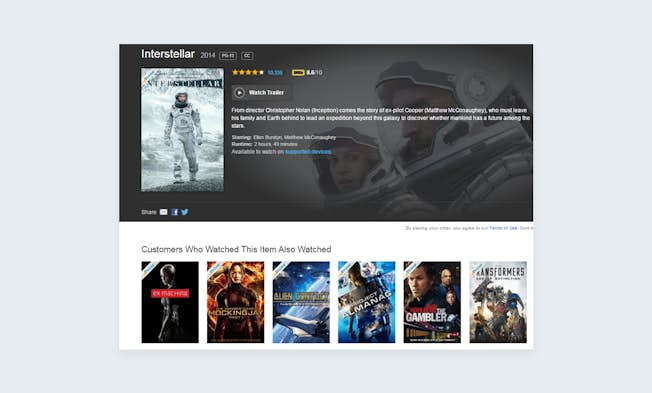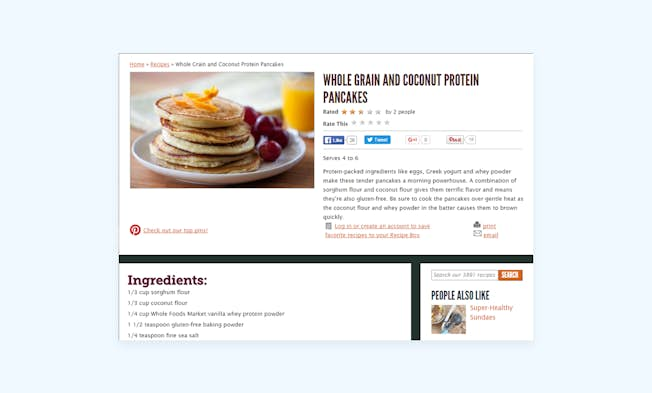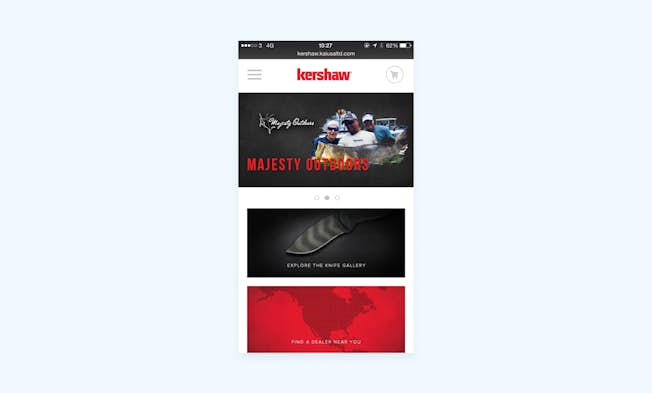When you consider the fact that there are 3 billion internet users worldwide (that’s over 40% of the global population!), it’s not surprising that the eCommerce industry is becoming an unstoppable force. Increasingly, we live, love and shop online; for me personally, that has entailed everything from a pair of ill-fated roller skates and a $70 vintage (once white, now yellowing) t-shirt with holes in it that my mom tried to throw out during a trip home.
“In 2015, retail eCommerce sales worldwide amounted to 1.67 trillion US dollars; this figure is projected to grow to 3.55 trillion in 2019.”
It’s hard to resist the allure of online shopping; the expedience of home delivery, the variety of products, the comforting validation of customer reviews. And it’s not just me!
As more consumers go online to research and ultimately make their purchases, brands are being presented with the opportunity to capitalize on expanding online profit margins and acquire and retain more customers. This article outlines how you can implement an easy-to-manage eCommerce strategy and yield maximum results with minimum exertion!
Step One: Get Personal – Adopt A User-Focused Approach
Everybody likes to feel special. As brands increasingly begin to recognize the benefits of connecting to their customers in a more personal, tailored way, you can’t afford to serve yours a standardized shopping experience that doesn’t accommodate their preferences. One size doesn’t fit all; if you adopt a user-focused approach, you can better engage and maintain the attention of potential customers, drive more sales and achieve a deeper level of brand loyalty which triggers repeat purchase.
“45% of online shoppers claim that they are more likely to shop on a site that offers personalized recommendations”
So as much as possible, try to cultivate the same level of attentiveness on their site that customers would receive in a brick-and-mortar store. Beyond ensuring that your site has a clean layout, and is easy to navigate and search, you can achieve that personal touch by implementing some of the following:
Dynamic Pages
Your web pages already boast concise, compelling copy, and bold, appropriate imagery. Now all they need are unique content that’s generated based on the particular user visiting the page. Let’s say, you’re a fashion e-tailer targeting a user who has landed on the product page for a pair of running shoes. In addition to the product description and imagery, you could also generate content that markets similar or complementary products (i.e. more running shoes and sportswear).

Amazon’s product pages serve as an excellent example. Before a customer has even made their purchase, Amazon produce a series of relevant further recommendations that could persuade them to add even more products to their shopping cart, driving even more sales!
Personalized recommendations
Not too dissimilar to dynamic product pages, and equally powerful in attracting customers, are personalized recommendations. These could be based on a customer’s location (you could target them with appropriate offers across your site based on where they are in the world), their buying history (you could target them with complementary product recommendations in the cart), or their browsing history (if they have viewed products from a certain category on your site, you could display items from that category on the homepage)

Etsy’s homepage is a great illustration of how personalized recommendations can pique a potential customer’s interest and incentivize them to buy! (Yes, I’m aware that most of my personalized recommendations are feathers and no, it’s not as creepy as it looks.)
Loyalty Programs
Encouraging a potential customer to part with their personal information can be a daunting task, but if you approach it in a transactional manner, you’ll be surprised to find how much of an insight you can gain into your target audience! Loyalty programs, like a points system which will eventually yield exclusive discounts, vouchers or incentives, are a way of providing a personalized value to your customers. You reward their loyalty by encouraging even more purchases, which ultimately benefits both of you!
Step Two: Create Content To Convert Customers
The dizzying ascent of content marketing has been impossible to ignore, but beyond its common functions of increasing brand visibility and generating leads, persuasive, well-crafted content can be a very effective mechanism for eCommerce success. Let’s put it into context; according to AdAge, Kraft Foods Group (responsible for culinary delights ranging from Jell-O to Philadelphia cream cheese) approximates that they have generated 1.1 billion ad impressions a year and a x4 more enhanced ROI through content marketing alone.
Compelling content will also help to build your brand, invigorate your social media channels and improve your site’s search ranking. Have I convinced you yet?! You can easily incorporate a touch of content marketing into your ecommerce strategy by taking one (or all!) of the below actions:
“Building on the idea of putting effort into personalization, if you invest a little energy in creating informative, valuable content for your target audience, you will be able to maintain their interest, win their trust and convert them into customers.”
Build a blog
Don’t be intimated by the prospect of committing to a blog, even if your resources are limited. You don’t need to post 3000 word epic monologues or spend money you don’t have on wildly creative formats that don’t fit your brand or purpose. All you need to do is decide on a posting schedule and stick to it (be it bi-weekly, weekly or fortnightly), and make sure that whatever content you create provides genuine value to your audience. Think of your blog posts as a way to further showcase your product offerings (without going for the hard sell). Create content that addresses customer pain points and highlights your USPs. A blog that incorporates information and explicit Calls-To-Action can help you to drive more traffic, and consequently, more sales.

American natural foods chain Whole Foods take a simple but ingenious approach to content. Their blog is composed of beautifully photographed, healthy recipes… and they know just the place where you can quickly and conveniently purchase your ingredients!
Get sticky with it
As an extension of the benefits of a blog, you can create standalone pieces of content and showcase them site-wide in order to encourage visitors to stay as long as they need to make a purchase. Whether it’s an instructional how-to video that demos the use of a product, or an interview with an industry influencer or brand ambassador, or beautifully designed FAQs, strategically placed content across a site ensures that you can attract and resonate with customers, catching them at every stage of the funnel. Even better, you can crowd-source content in the form of customer reviews. A popular approach with fashion e-tailers, it minimizes the effort required by brands to create content and makes the customer feel like their opinions matter, which instills increased brand appreciation and loyalty.

ASOS are masters of creating aspirational, super sticky content for their site visitors. This example celebrates the outfit details of a conveniently gorgeous German fashion blogger!
They go on to showcase several of their own products that will enable a reader to emulate the blogger’s look, before seeking feedback on the content; a quick but ingenious way to gain insights that will help to optimize their future content marketing efforts.
Step Three: Provide A Social Customer Experience
At the core of every organization, large or small, should be an implicit understanding that customers are critical to their success. As eCommerce has facilitated an excess of choice for consumers, it’s now even more important for brands to provide an impeccable level of customer service to set themselves apart from the competition. Cultivating a superior customer experience not only encourages brand loyalty and repeat purchase; it’s a highly effective method of promotion, particularly for companies with small marketing budgets who may rely on word-on-mouth to elevate their brand visibility. In fact, so much emphasis has been placed on the provision of outstanding customer service, that by the year 2020, customer experience will overtake price and product as the key brand differentiator. You can adopt a seamless social media-driven approach to customer service to accompany your eCommerce strategy:
Build an online community
Establishing a consistent brand experience across multiple social media platforms will provide your customers with an essential level of flexibility and choice when it comes to choosing their support channel, as it’s likely that they could reach out to you via more than one. It wouldn’t be uncommon for a customer to contact a company with a Tweet and follow up with a Facebook message, especially if their query or concern was particularly pressing!
Focus on providing swift responses, as soon as you feasibly can, and remember that the longer you leave a customer waiting, the less likely it is that they will want to purchase from you, now or in the future. During every interaction you have with a customer, put yourself in their position; empathize with, relate to them, whether you’re receiving positive feedback or attempting to solve a problem. Live chat functions are another great way to provide instant customer support but if that isn’t an option for you, it’s important to make sure you are contactable via email (whether it’s a contact form or generic customer service email address) or telephone, in addition to social media. Communication is key; if a customer feels like their voice is being heard, it reflects favourably on your brand, so give them the opportunity as much as possible. And don’t forget to humanize your brand and keep it personal to the individual or…

Leverage social listening
Catering to what your customers want and need is the best way to improve your brand perception and encourage more sales. All you need to do is listen! From Buzzsumo, to SproutSocial, there are a wealth of social listening tools available that will allow to you research and gain a valuable insight into your customers’ needs, what kind of social conversations they’re having, what kind of content they’re consuming. This will enable you to target them with specific deals or offers, engage them in meaningful conversation, and post content that is most likely to attract their attention; all of which will assist your eCommerce efforts!
Step Four: Mobilize Your Strategy
One of my favorite digital marketing statistics ever is that there are more people in the world who own a smartphone than a toothbrush. Mainly because it makes me wonder; are there really people out there that own a smartphone but no toothbrush? And if so, how do they clean their teeth? Do they even own toothpaste? Questionable levels of hygiene aside, it’s an unavoidable fact that in order to be successful, an eCommerce strategy must consider mobile users; especially as four out of five smartphone owners use their devices to buy online.
Mobile commerce harnesses the accessibility and universality of smartphone culture, transcending the convenience of eCommerce to propel more sales, so much so that mCommerce now accounts for over one third of global eCommerce. You can easily take advantage of this mushrooming trend by being slightly more mindful of mobile users.
Adapt your site for usability
Ensuring your mobile customers have an equally seamless shopping experience to desktop users doesn’t have to mean creating an entirely separate site. Opt for a responsive design that’s optimized for mobile traffic to ensure a consistent customer experience regardless of what device they’re using. This also saves you time and resources as you won’t have to create new images or content for a smaller screen (think big images and typography from the outset).

Kershaw Knives’ website has gained recognition for its responsive design, which incorporates an easy-to-browse product gallery with striking images, uses geo-location to find the users’ nearest supplier, and benefits from a clean, simple layout.
Adopt a user-friendly checkout process
Did you know that 30% of mobile shoppers abandon a transaction if the shopping experience is not optimized for mobile? If you’ve gone to the effort of utilizing a responsive design for your website, don’t forget to consider the checkout process from a mobile user’s perspective too! Taking into account these customers don’t have a mouse, keyboard or large desktop stream, try to streamline their path to purchase much as possible. Limit contact form fields to the essentials, to reduce the need to pinch and zoom painstakingly. Allow users to checkout as a guest rather than forcing them to create and confirm an account (this presents an unnecessary obstacle). And finally, consider alternative mobile payment options! Services such as PayPal or Google Wallet are infinitely less awkward than filling in numerous credit card details and allow customers to complete their transaction in a few simple steps!
- Categories:
- Articles
- E-Commerce
Upgrade to Power Membership to continue
your access to thousands of articles, toolkits, podcasts, lessons and much much more.
Become a Power Member- Login
- View Courses
- - - -
- Courses
- Resources
- - - -
- My Account
- Change Password
- Logout




